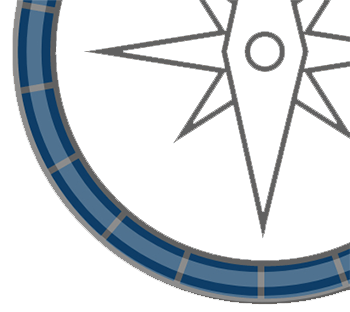
Sam Davies grows wings
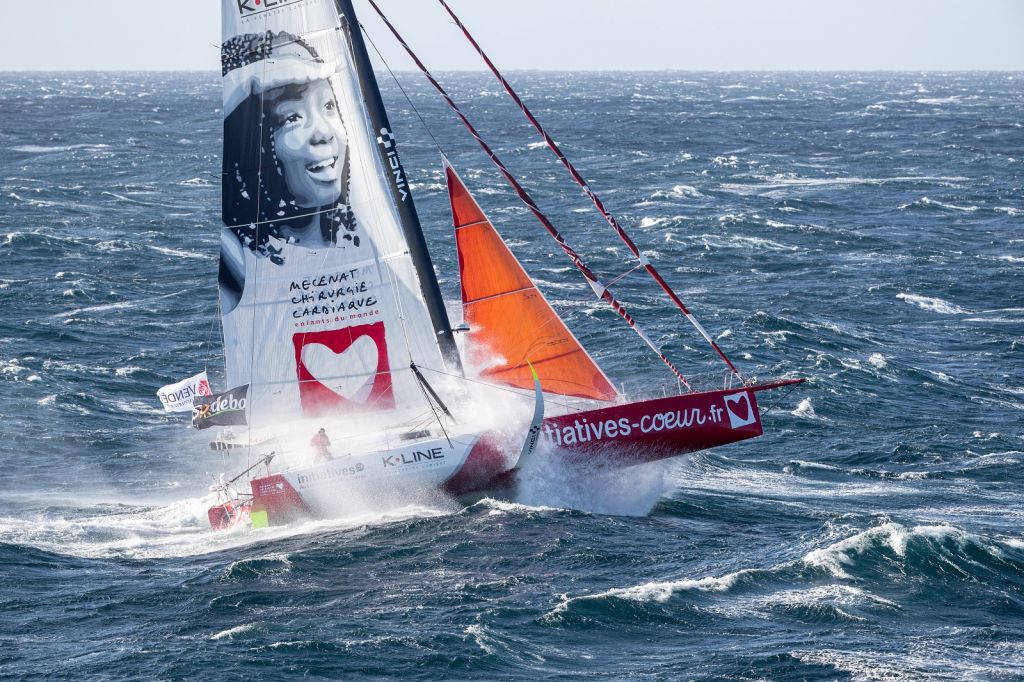

In the lead up to the Vendée Globe start on 8 November, we are featuring RORC women members who are sailing in the race, starting this week with Sam Davies and followed by Miranda Merron and Pip Hare.
While Alex Thomson returns as one of the favourites for what will be his fifth attempt at the Vendée Globe, back for merely a third time is Sam Davies, skipper of Initiatives Coeur, who many pundits believe may be the dark horse of this winter’s solo non-stop lap of the planet.
To recap a little, Sam took her older generation boat Roxy to what seemed to be fourth place in 2008, after 95 days at sea finishing 1 hour 20 minutes from third, although she was later bumped down a place after Vincent Riou received redress for rescuing Jean le Cam. Four years later, Sam became a statistic when her Savéol dismasted five days in and 2016-17 she sat out the Vendée Globe, firstly because she was freshly home from skippering Team SCA in the Volvo Ocean Race and secondly because her partner Roman Attanasio was himself competing in the Vendée Globe and someone had to look after their son Ruben.
This time Sam is back and, uniquely, both mummy and daddy are competing in this Vendée Globe, albeit at different levels, with Attanasio on Pure-Best Western, formerly Gitana Eighty, built in 2008 for Loick Peyron. (And in case you’re wondering, Sam’s parents will look after Ruben while they are away).
While this time there are six female competitors (impressively three from the UK), Sam was the sole female competitor in 2012 and zero women took part four years ago. On that occasion Sam believes she was partially responsible: “I wasn’t there, and Dee [Caffari] and possibly Liz [Wardley] and Justine [Mettraux] too because we were sailing Team SCA in the Volvo Ocean Race. I am not sure it’s good that one crew in another race can hijack all the top women sailors! Obviously the diversity in our sport needs to evolve a bit more so that doesn’t happen again.”
The Vendée Globe is impressive because, while so many other pinnacle events in sailing struggle for entries, for the solo non-stop round the world race it is typically standing room only. This time there are an incredible 33 IMOCAs representing seven nations.
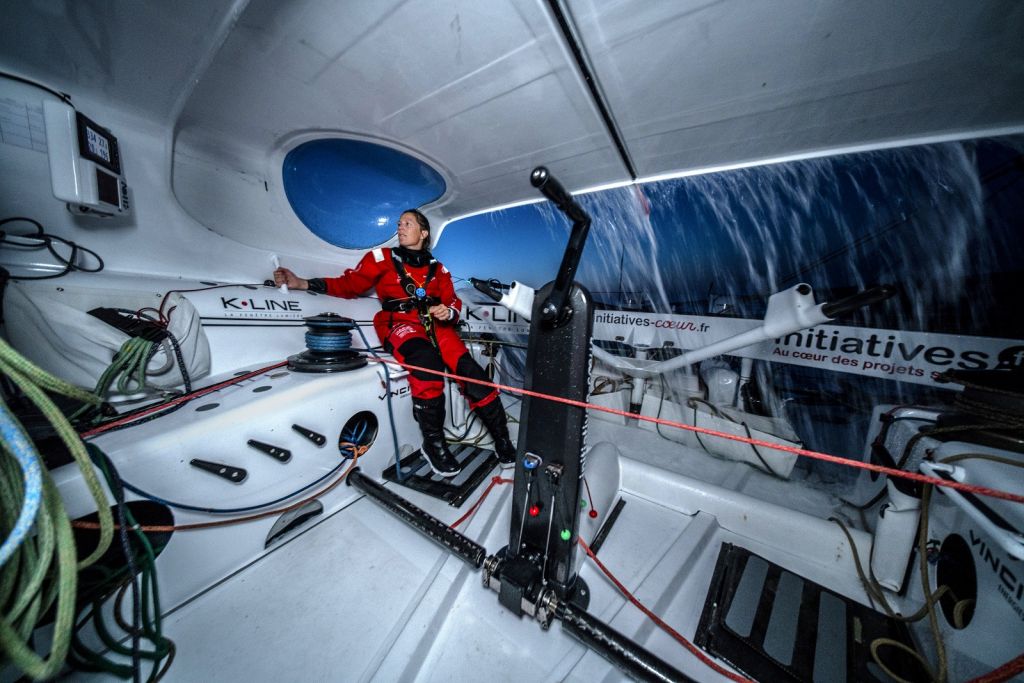 Sam Davies in the cockpit of Initiatives Coeur © Yann Riou
Sam Davies in the cockpit of Initiatives Coeur © Yann Riou
So why is the race so successful? Sam: “There’s its simplicity - the fact that you are sailing around the world non-stop on your own and you are not allowed outside assistance. It is so simple, even non-sailors understand that. And it remains a real human adventure - you can imagine doing it. Obviously, I do enjoy the competition side of it, but the strength of the race is the fact that it is an adventure and it remains an extreme one and there are only 80 or so skippers who have ever finished it. There are way more than that who have been up to the space station...”
Another reason is because you can compete at so many levels, as demonstrated by the British campaigns: Those with new boats and big teams will get little change from £10 million, while Pip Hare’s campaign with an old chartered boat is one tenth that. “For most of us just crossing the finish line is a victory. There are perhaps only two people in the whole fleet who are just in it to win.
Sam continues: “Obviously you have to have an IMOCA and you have to have enough budget to attempt it safely and to qualify, which is not easy, but otherwise there is not a set budget you need to achieve before you can go and do it. That is great because if you just have the ambition to sail around the world you can do this race with a more entry level budget unlike other offshore races, where there is a certain level of budget you have to achieve to compete.”
Sam’s campaign falls into the second tier in that her team didn’t acquire a new IMOCA for this race but she has one of the most competitive older generation boats.
She came to this project in an unusual manner, taking over its reigns from the popular Tanguy de Lamotte, who competed in the last two Vendée Globes and has since moved to San Francisco.
The Initiatives Coeur campaign is very soul warming in that it involves the campaign’s French backers Initiatives, K Line and Vinci Energies making donations to the charity Mécénat Chirurgie Cardiaque that helps children from poor countries born with heart defects. “It is an amazing charity to be able to support: It helps these kids by diagnosing their illness and then bringing them to France where they are put up with a host family. They get an operation, get fit and most go back to their families. It is amazing to help them.”
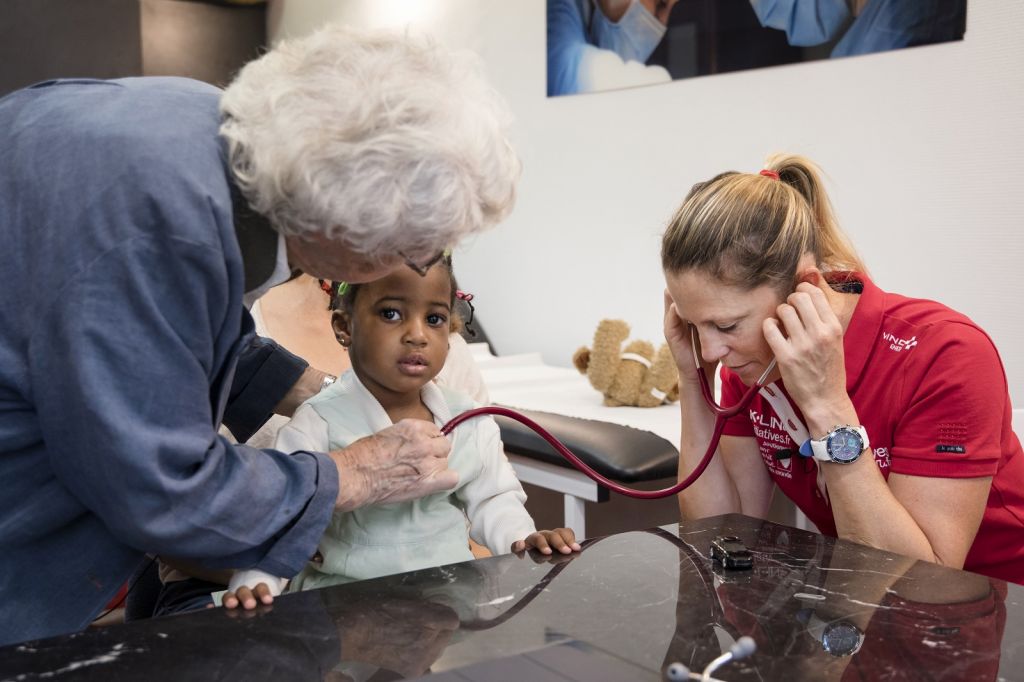 Sam Davies is passionate about the Initiatives Coeur campaign © Michel Slomka
Sam Davies is passionate about the Initiatives Coeur campaign © Michel Slomka
For every race their campaign runs a fund raising campaign that works in 12,000 Euro chunks, which is what it costs to save one child’s life (at the time of writing they had already saved three within a week and a half). “It’s called ‘one click one heart’ or ‘1 Euro per click (https://www.facebook.com/initiativescoeur),” continues Sam, who has been out to Burundi to see the charity’s work first hand. “It costs the public nothing - for every like, click and share made on our Facebook page, my sponsors will all donate 1 Euro. We are aiming to raise enough money to save a number of kids’ lives during the Vendée Globe this way.” As a continual reminder of what is at stake an image of one of the children, whose life her campaign helped save, is emblazoned on her mainsail. “If I’m having a bad day, I look up and it reminds me what I am really out there doing this for. It is pretty motivating - I definitely sail harder because of this.”
Back to less cerebral matters and for this race, Sam isn’t campaigning a new boat. This she prefers as it places less pressure on her. In fact her VPLP-Verdier designed IMOCA is two races old, originally finishing second in 2012-13 as Armel le Cleac’h’s Banque Populaire (sistership to the winner MACIF) and then, with new generation lifting foils fitted, to third place four years ago as Jérémie Beyou’s Maître CoQ.
For this campaign she acquired the boat from Beyou and sailed it for two seasons with his set of foils. In the second season her team fitted a hydraulic rake control system to her foils in line with a newly introduced IMOCA class rule. “Pretty much everyone has got what we designed,” says Sam of that development. “We intended to test it out on a small and low load scale, so that we would know where we were going with the big one.”
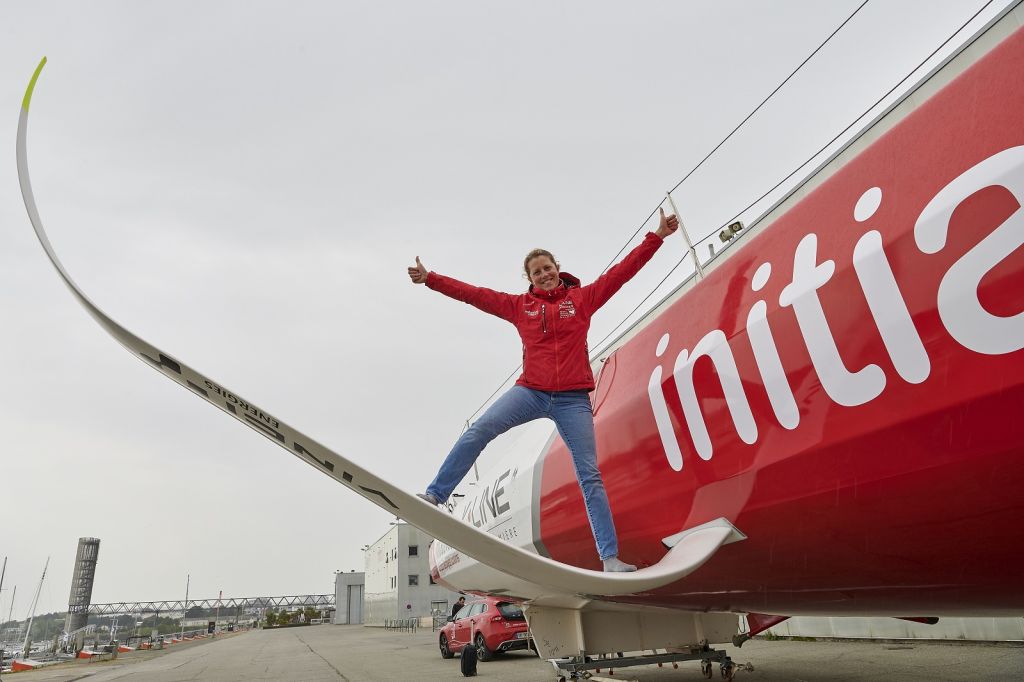 Sam Davies shows off her foils on Initiatives-Coeur © Yvan Zedda
Sam Davies shows off her foils on Initiatives-Coeur © Yvan Zedda
Initiatives Coeur now has a new generation set of Guillaume Verdier-designed foils. When it comes to foils, Verdier is one of the most advanced yacht designers in the world due to his recent AC campaigns with Emirates Team New Zealand. Having these new giant, impossibly intricate foils designed and built was only possible when a new backer for her campaign came on board in Vinci Energies. While Verdier did the core design work, much of the practical side of their installation and development was carried out by Initiatives Coeur’s in-house engineer Anne-Clare Leberr. While Sam herself holds an engineering degree from Cambridge, Leberr, a top sailor in her own right, gets to fully focus on the technical side of the campaign.
While Jérémie Beyou’s Charal was the first new generation IMOCA to launch this cycle, Initiatives Coeur was the first to install the very latest generation Verdier foils, very different to Charal’s. As Sam recalled of their reveal: “There were paparazzi hiding around the dock with massive cameras. I wondered which teams had sent them...”
Other than the constraints of the position of the boat’s bulkheads, a limit to the righting moment they’d produce and being optimised for the Vendée Globe (ie all-round off the wind), Verdier was given a blank sheet of paper to design them and the result is...huge. “They look big because they don’t have a very long shaft,” says Sam. “The short shaft is curved and acts like a hinge, so when they are retracted they don’t go very far into the boat, they just lift up. The tip is long, tapered and very thin - like albatross wings. Quite cool!”
An aspect of the mega-foils Sam finds interesting is how their shape changes once the foil is in use. In theory their bend characteristic is such that if they load up too much they twist and unload prior to creating excess lift. While much R&D work into this has been carried out in the America’s Cup, Sam acknowledges that it is still early days for such foils fitted to boats which heel and that must handle waves in addition to the hugely complex tech that involves two media – water and air – in an exotically shaped span of high-tech carbon that must withstand the entire weight of the boat. The foils’ role is also two-fold – most noticeably it elevates the boat out of the water to reduce drag, but also it creates upward force to leeward (like a DSS foil) thereby improving righting moment.
To get them up and running they endured lengthy teething issues: “To start with it was how to hold the foil down without them slipping up. Once that was fixed, we realised they weren’t pushing as much as they should; they were unloading themselves.” Verdier’s colleague Benjamin Muyl sailed on board and quickly found a solution: The foils were lacking strategically placed gates along their length, to prevent ventilation and help guide the path of the water across the foil’s surface.
For Initiatives Coeur there was the added issue of having giant foils when she was not originally designed to fly. She still has her original 2012 generation keel, which has its main bearing angled upwards towards its front so that when the keel cants the foil develops lift, reducing hull immersion, drag, etc. “Now we have the keel which pushes one side and the foil which pushes the other and we are going much faster than my boat was designed to go. So I end up tipping right over or doing massive kangaroo wheelies sometimes. That is when you have to drop your keel down...”
The new IMOCAs have keel foils that generate less lift thereby reducing this problem but their foiling will remain inelegant until such time as they are fitted with rudder elevators, like the America’s Cup boats.
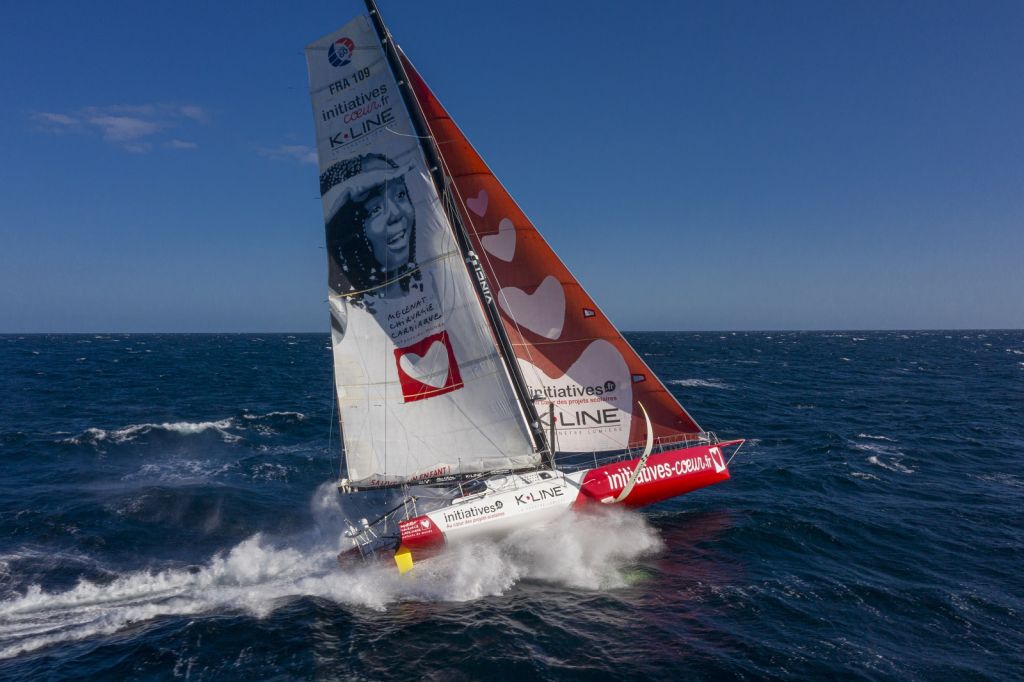 Taking advantage of the foils on Initiatives Coeur © Yann Riou / polaRYSE
Taking advantage of the foils on Initiatives Coeur © Yann Riou / polaRYSE
Otherwise the foils offer huge benefits. They act like stabilisers pinning the boat’s position in (or above) the water, and this makes it easier for the autopilot to steer in waves and gusts, even full-on running.
But their main bonus is pure speed. In the right conditions Initiatives Coeur is five knots faster than before. “There is a big step when your foils start working and lift your boat out of the water, reducing the drag. You start going really fast - you were doing 14 knots then suddenly you are doing 18. And that moment is in less wind than before.” A lot is down to technique apparent wind sailing. Sam remembers having Figaro champion Yann Eliès on board: “I remember being frustrated because he’d always take off while I’d get stuck in displacement mode.”
The worst time is in marginal foiling conditions, when there’s violent porpoising as the boat comes out of the water, picks up speed only to crash down again in a lull. This makes life on board uncomfortable in extremis. “You have big accelerations and decelerations which makes life quite difficult...” Fortunately Sam has previous experience of this aboard big multihulls like Maiden II and Royal & Sun Alliance.
AC and inshore foiling boat sailors have taken to wearing body armour and helmets, however there isn’t similar gear yet developed for offshore usage. “I wear knee pads 24/7. I am doing big research on ones you can wear non-stop for several weeks without getting a rash! The trouble with armour is that it isn’t breathable, so it is not compatible with a Vendée where you could have it on for weeks. For sure there are moments when I’ll put my helmet on when I go and stack, especially inside the boat, because you can’t see what’s coming.
“You don’t hang around in the middle of the cabin. You get dressed as quickly as possible, generally with your back to the bulkhead so that if the boat stops while you have one leg in your trousers, you don’t fly too far. You have to think twice about what you are doing and where you’ll end up if you crash into a wave and if that will damage you or any part of the boat which could have serious consequences.”
There is the option of strapping into a padded chair as on offshore powerboats, but Sam claims she fidgets too much. Instead Initiative Coeur’s interior resembles a padded cell or a children’s soft play centre.
To sleep Sam uses a mattress-shaped beanbag that has its own shock-absorbing system in its polystyrene balls. She has also evolved the length of time that she sleeps. “I do more lying down sleeping than I did before when I was catnapping and half sitting-up sleeping. But living on our boats is so physical now - with all the sail changes and your legs shock absorbing the whole time - so when I did the Vendée-Arctique-Les Sables d'Olonne race, right from the start my shortest sleeps were 40 minute, whereas before that would have been my longest sleep.” This has noticeably improved her energy level and her decision-making which often suffer through sleep-deprivation she says.
If this Vendée Globe is a heavy one, coming with a high attrition rate from the new foilers, then this could bode well for the 45-year-old the French call Samantha since her boat works equally well in displacement mode.



